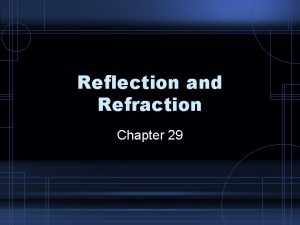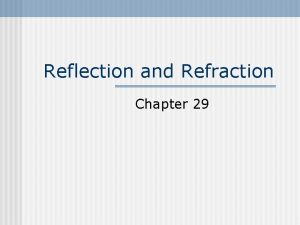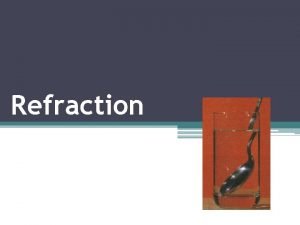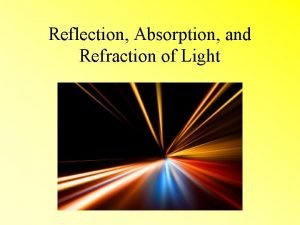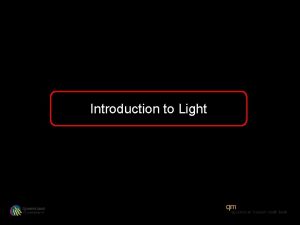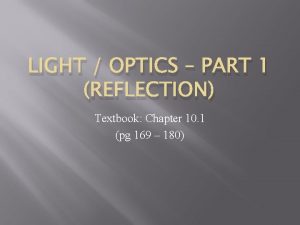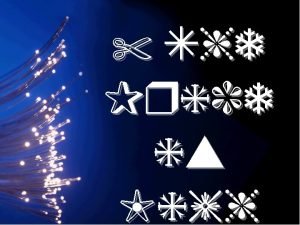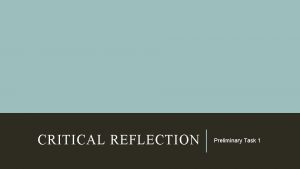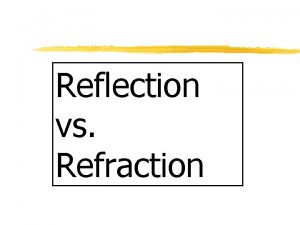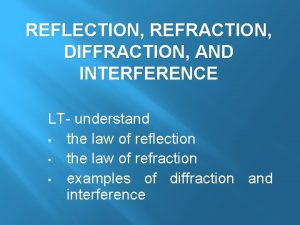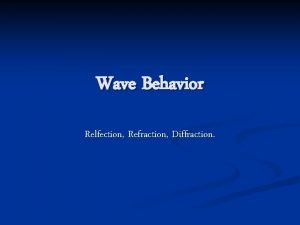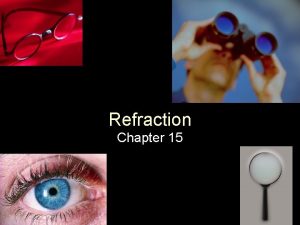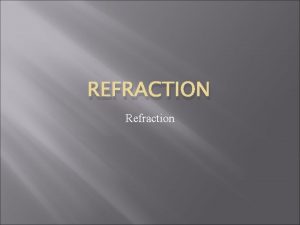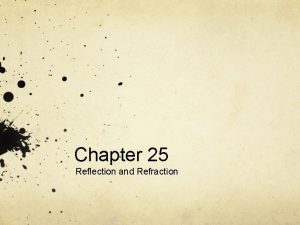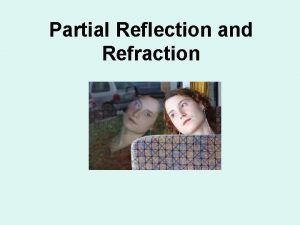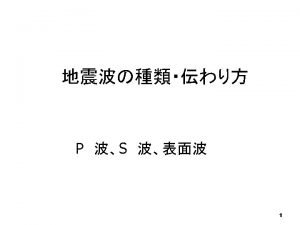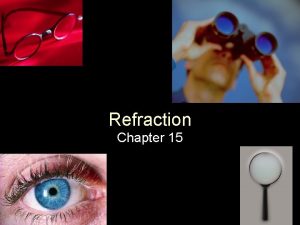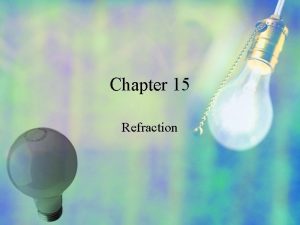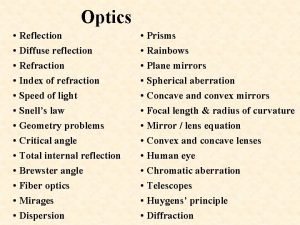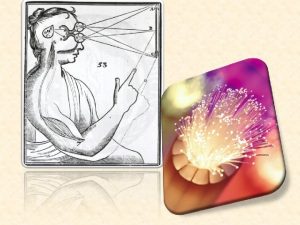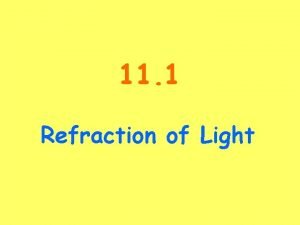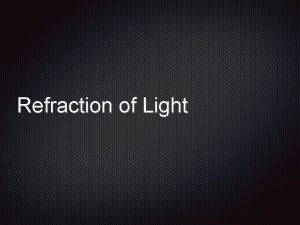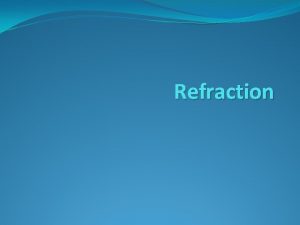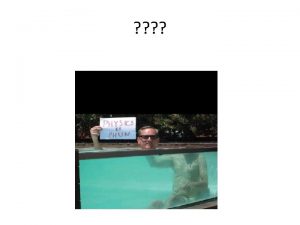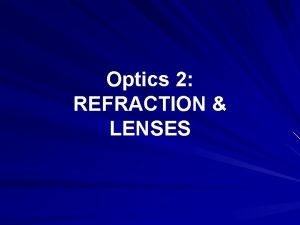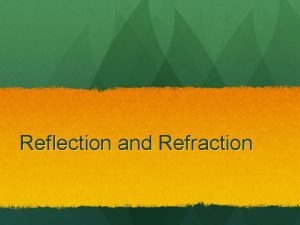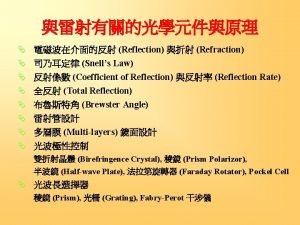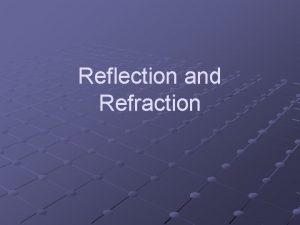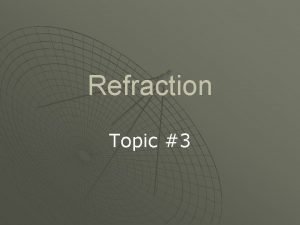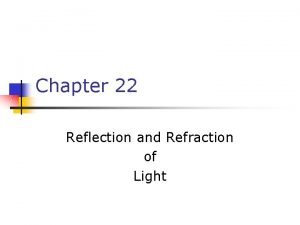Reflection and Refraction Chapter 29 Reflection Reflection some

























- Slides: 25

Reflection and Refraction Chapter 29

Reflection • Reflection – some or all of a wave bounces back into the first medium when hitting a boundary of a second medium • When all the wave energy is reflected back instead of being transmitted, it is total reflection • If some energy is transmitted and some is reflected, the wave is partially reflected

Reflection

The Law of Reflection • The direction of incidence and reflection is best described by straight-line rays • Incident rays and reflected rays make equal angles with a line perpendicular to the surface, called the normal • Angle of Incidence – angle made by the incident ray and the normal • Angle of Reflection – angle made by the reflected ray and the normal • Law of Reflection – the angle of incidence and the angle of reflection are equal

The Law of Reflection

Mirrors • Virtual Image – the point located behind a mirror where an object appears to originate • Your eye cannot tell the difference between an object and its virtual image • The image is as far behind a mirror as the object is in front of the mirror

Diffuse Reflection • Diffuse Reflection – light incident on a rough surface is reflected in many directions • A surface’s roughness is dependent upon the wavelength of the wave incident upon that surface; the longer the wavelength, the smoother the surface will appear • To a piece of paper, light is reflecting diffusely

Diffuse Reflection

Reflection of Sound • An echo is reflected sound • Sound reflects from all surfaces of a room • Acoustics is the study of the way sound reflects off of objects in a room • Reverberations – Multiple reflections of sound within a room • The walls of concert halls are designed to make the reflection of sound diffuse

Reflection of Sound

Refraction • Refraction – the change in direction of a wave as it crosses the boundary between two media in which the wave travels at different speeds • Wave Fronts – lines that represent the position of different crests • At each point along a wave front, the wave is moving perpendicular to the wave front • The direction of motion is best represented by a ray

Refraction

Refraction of Sound • Sound waves are refracted when parts of a wave front travel at different speeds • This happens in uneven winds or temperatures • Sound waves tend to bend away from warm ground, since it travels faster in warmer air • On a cold night, the speed of sound is slower near the ground than above, so we can hear over larger distances

Refraction of Sound

Refraction of Light • A pond or swimming pool may appear shallower than they actually are, a pencil in a glass of water will appear bent • All of these effects are caused by changes in the speed of light as it passes from one medium to another, or through varying temperatures and densities of the same medium – which changes the directions of light rays • Index of Refraction (n) = (speed of light in vacuum)/(speed of light in material) • Snell’s Law: n sin θ = n´ sin θ´ (where n and n´ are the indices of refraction of the media on either side of the boundary, and θ´ are the respective angles of incidence and refraction)

Refraction of Light

Atmospheric Refraction • On hot days there may be a layer of very hot air in contact with the ground, the light will travel faster through this air and will bend, creating a mirage • When you watch the sun set, you can still see the sun for several minutes after it has sunk below the horizon, because light is refracted by Earth’s atmosphere

Atmospheric Refraction

Dispersion in a Prism • Light of frequencies closer to the natural frequency of the electron oscillators in a medium travels more slowly in the medium • Since different frequencies of light travel at different speeds in transparent materials, they will refract differently and bend at different angles • When light is bent twice at nonparallel boundaries, as in a prism, the seperation of the different colors is apparent • Dispersion – the separation of light into colors arranged according to their frequency

Dispersion in a Prism

The Rainbow • The rainbow takes the concept of dispersion and multiples it through the atmosphere • The sun shines on water droplets in a cloud or when it is raining • The light is dispersed by the raindrop into its spectral colors

The Rainbow

Total Internal Reflection • Critical Angle – the minimum angle of incidence for which a light ray is totally reflected within a medium • Total Internal Reflection – the 100% reflection of light that strikes the boundary between two media at an angle greater than the critical angle • Optical fibers utilize the concept of total internal reflection to feed light from one location to another, these cables are very useful for communications

Total Internal Reflection

Assignment (Due ¾) • Read Chapter 29 (pg. 442 -459) • Do Chapter 29 Assessment #28 -41
 Chapter 29 reflection and refraction
Chapter 29 reflection and refraction Refraction of sound
Refraction of sound What is your reaction of the poem
What is your reaction of the poem Refraction examples
Refraction examples Reflection refraction absorption
Reflection refraction absorption Light energy bill nye
Light energy bill nye Invictus reflection
Invictus reflection Why can we represent light rays using a ruler
Why can we represent light rays using a ruler Bill nye light optics worksheet
Bill nye light optics worksheet Reflection and refraction venn diagram
Reflection and refraction venn diagram Venn diagram of reflection and refraction
Venn diagram of reflection and refraction Lighthe
Lighthe Reflection and refraction learning task 1
Reflection and refraction learning task 1 Refraction vs reflection
Refraction vs reflection Reflection refraction diffraction interference
Reflection refraction diffraction interference Refraction vs diffraction
Refraction vs diffraction How are refraction and diffraction similar behaviors
How are refraction and diffraction similar behaviors Reflection refraction
Reflection refraction Force and motion
Force and motion Some trust in chariots and some in horses song
Some trust in chariots and some in horses song They say it only takes a little faith to move a mountain
They say it only takes a little faith to move a mountain Sometimes you win some sometimes you lose some
Sometimes you win some sometimes you lose some Ice cream is countable or uncountable
Ice cream is countable or uncountable Fire and ice diamante poem
Fire and ice diamante poem Some say the world will end in fire some say in ice
Some say the world will end in fire some say in ice Raindrops sunlight and refraction lyrics
Raindrops sunlight and refraction lyrics
